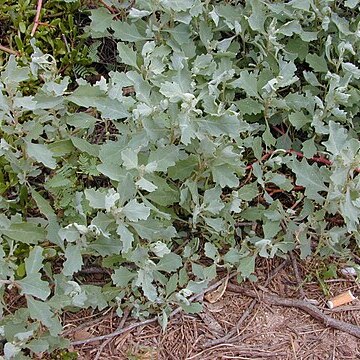Sprawling herb branching from base, to 60 cm high, monoecious. Leaves thin, narrow to broadly rhomboid, 15–30 mm long, coarsely serrate, shortly petiolate; upper surface glabrescent, lower surface somewhat scurfy. Male flowers in subterminal clusters. Female flowers in axillary clusters. Fruiting bracteoles shortly stipitate the stipe sometimes thickening with age; bracteoles rhomboid, acute, c. 2–5 mm long, ± flat or convex, connate in lower half, thin or somewhat thickened with age, scurfy pubescent; margin entire in lower half, 2–4 toothed in upper half. Seed circular; radicle lateral, erect.
Annual herb, 0.07-0.70 m high, decumbent or suberect. Leaves up to 60 x 30 mm, ovate, elliptic or oblong, base cuneate, apex obtuse, with 1-5 coarse teeth on each margin, upper surface glabrous with reticulate venation, lower surface with mealy grey to white vesicular scales and main vein prominent. Flowers clustered in leaf axils, upper clusters male, lower female. Flowering time Oct.-Feb. Fruiting bracts with basal connate part ± 2 mm long, hardened and pale, free apical part semicircular to triangular in outline 2-3 mm long, apex subacute with 1-4 small teeth on each margin.
Annual or perennial herb, up to 0.75 m high; monoecious. Stems decumbent-erect, subwoody, up to 1 m long. Leaves herbaceous, weakly scaly, green, shortly petiolate; blade narrow to broadly rhombic, 10-50 x 5-35 mm, apex rounded, base cuneate, margins coarsely, irregularly, sinuately dentate or lobed, upper surface mealy pubescent. Flowers: female flowers in axillary clusters; fruiting bracteoles weakly rhombic with broad, deltoid, apical lobes, with a distinctive base, toothed, green; Sep.-Mar. Fruit with a stipe-like solid base, first to swell and indurate.
An annual herb. It can grow to 60 cm high. It branches from the base. The leaves are thin and narrow. They are 2-3 cm long and have coarse teeth along the edge. The male and female flowers are separate but on the same plant. The flowers are small and pale green and 2 mm across. The male flowers are in clusters at the top of the plant while the female flowers are in clusters in the axils of leaves. The fruit is a flattened capsule 5 mm across.
Monoecious, annual or perennial herb, with a subwoody base, up to 750 mm tall, with decumbent to erect branches, ± covered with swollen-based clear scale-like hairs. Leaves ovate to rhomboid, cuneate at base, coarsely sinuate-dentate, mealy above, scaly beneath. Flowers minute in axillary clusters. Fruiting bracteoles stipitate at base, broadly deltoid above, with apical lobes, ± bony.
Fruiting bracteoles almost sessile, their basal connate part about 2 mm. long, obconical or campanulate, becoming thick hard and pale; free apical part of each bracteole semicircular to triangular in outline, 2–3 mm. long, 1.5–3.5 mm, wide acute or subacute at apex, with 1–4 small teeth on each margin; bracteoles in centre smooth or venose, not at all tuberculate or muricate.
Leaves variable in shape, in outline ovate to elliptic or oblong, 1–6 cm. long, 0.5–3 cm. wide, mostly obtuse to subtruncate at apex, cuneate to attenuate at base, normally with 1–5 coarse teeth on each margin; inferior leaves occasionally subentire or entire; grey vesicular hairs scattered and often sparse on both surfaces except on young leaves.
Decumbent-erect or erect annual or perennial herb, up to 0.75 m high. Leaves rounded at apex. Fruiting bracts with broadly deltoid apical lobes, toothed. Fruit with stipe-like solid base which is the first to swell and Indurate. Flowers green.
Flowers clustered in leaf-axils, upper clusters male or mixed, lower female.
Annual herb, 12–60 cm., decumbent to suberect.

